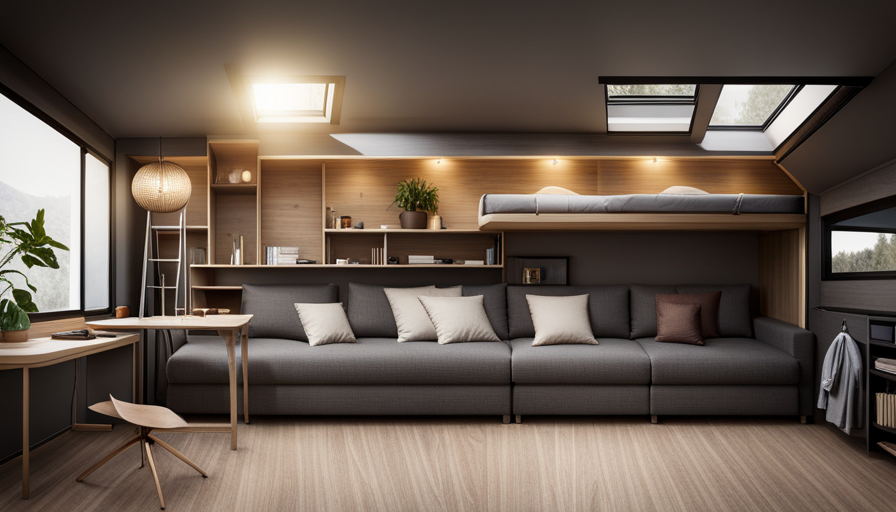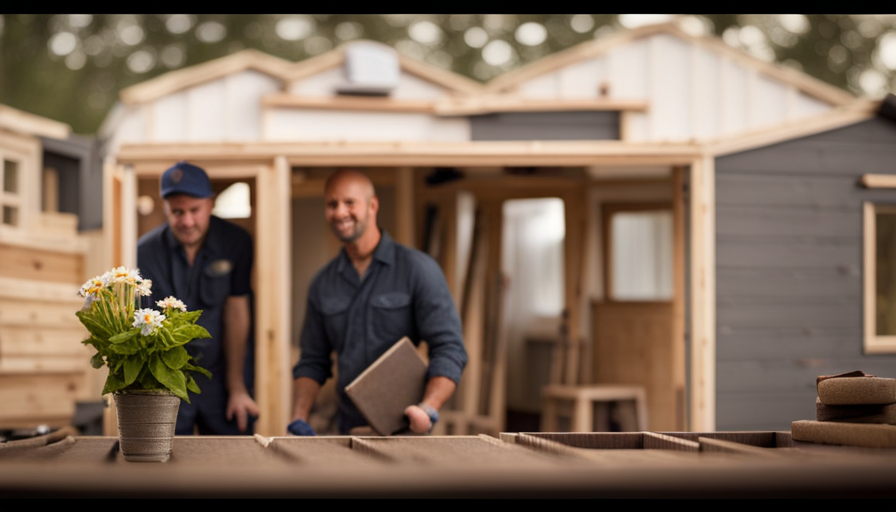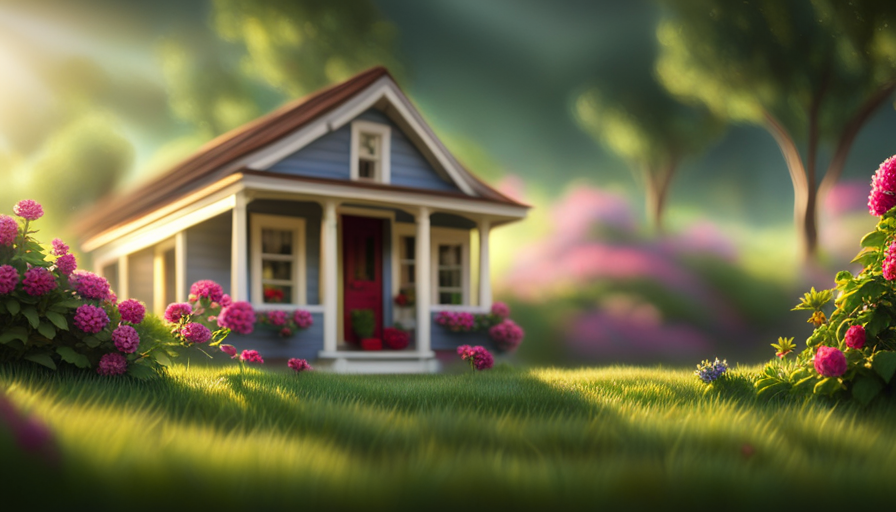Have you ever wondered what the maximum size of a small house in New Zealand can be? Prepare yourself for some unexpected revelations. In this article, I will reveal the boundaries of how large tiny houses can be in NZ and present you with creative design tactics to optimize your space. Get ready to delve into the world of practical and spacious tiny home living.
But before we get into the nitty-gritty details, let’s first understand the definition of a tiny house in New Zealand. It’s not just about size; it’s about a way of life. Tiny houses are compact dwellings that prioritize simplicity, sustainability, and minimalism. They offer an opportunity to live more intentionally and reduce our environmental footprint.
So, how big can a tiny house be in NZ? The answer might surprise you. Stay tuned as we explore the regulations and guidelines that govern the size of these unique dwellings. Get ready to be inspired by real-life examples of stylish and comfortable tiny houses that prove that size doesn’t always matter when it comes to creating a cozy and functional home.
Key Takeaways
- Tiny houses in New Zealand can be as small as 10 square meters and built on a trailer or foundation.
- Compliance with the Building Code, including health and safety requirements, is necessary for tiny houses in NZ.
- The maximum floor area for a tiny house in NZ is 30 square meters and the maximum height is 4.25 meters.
- Designing a functional and spacious tiny house involves utilizing natural light, open floor plans, and creative storage solutions.
Understanding the Definition of a Tiny House in New Zealand
In New Zealand, a tiny house can be as small as 10 square meters, allowing for a cozy living space with just enough room for the essentials. The definition of a tiny house in New Zealand is a dwelling that’s compact, efficient, and designed to maximize the use of limited space.
These houses are built on a trailer or a foundation and can be mobile or stationary. When it comes to regulations in NZ, there are certain guidelines that must be followed. For instance, tiny houses must comply with the Building Code, which includes requirements for health and safety, insulation, and fire safety. Additionally, there may be restrictions on the minimum size of the land where a tiny house is located.
Moving on to the maximum size restrictions for tiny houses in New Zealand…
The Maximum Size Restrictions for Tiny Houses in New Zealand
To fully understand the limitations on size for your compact abode in New Zealand, you must familiarize yourself with the maximum dimensions set forth by regulations. The maximum size restrictions for tiny houses in New Zealand are determined by building regulations. These regulations outline the maximum dimensions for both the floor area and height of a tiny house. According to the New Zealand Building Code, the maximum floor area for a tiny house is 30 square meters. Additionally, the maximum height for a tiny house is 4.25 meters. It is important to adhere to these restrictions when designing and constructing your tiny house to ensure compliance with the building regulations. By understanding and following these maximum size restrictions, you can ensure that your tiny house meets the legal requirements in New Zealand. This will allow you to focus on exploring creative design solutions to maximize space in your compact dwelling.
Exploring Creative Design Solutions to Maximize Space in Tiny Houses
Get ready to unlock your creativity and make the most of your compact living space by exploring innovative design solutions for maximizing space in your tiny abode.
When designing a tiny house in New Zealand, it’s essential to prioritize storage solutions to ensure that every square inch is utilized efficiently. Maximizing storage can be achieved through the use of built-in cabinets, shelves, and hidden compartments.
Additionally, consider incorporating creative furniture solutions such as multi-purpose pieces that serve multiple functions. For example, a sofa that can be converted into a bed or a coffee table with built-in storage. These design choices will help create a functional and spacious living environment within the constraints of a tiny house.
Now, let’s delve into some tips for designing a functional and spacious tiny house in New Zealand.
Tips for Designing a Functional and Spacious Tiny House in New Zealand
One interesting statistic to engage the audience is that New Zealand has a high demand for tiny houses, with a 35% increase in the number of people choosing to downsize their living space in the past year.
Designing a sustainable tiny house in New Zealand requires careful consideration of space utilization and incorporating storage solutions. To maximize functionality, it’s essential to prioritize multifunctional furniture and smart storage options. Utilizing built-in shelves, hidden compartments, and foldable furniture can help optimize space.
Additionally, incorporating vertical storage solutions such as wall-mounted cabinets and hanging storage can further maximize space efficiency. Designing a spacious tiny house in New Zealand also involves utilizing natural light and open floor plans to create a sense of openness.
By carefully planning and utilizing these design strategies, it’s possible to create a functional and spacious tiny house in New Zealand.
Transitioning into the subsequent section about navigating the building consent process for tiny houses in New Zealand, it’s important to understand the regulations and requirements to ensure a smooth construction process.
Navigating the Building Consent Process for Tiny Houses in New Zealand
Navigating the building consent process for compact dwellings in New Zealand can be a complex endeavor, but with the right understanding of regulations and requirements, it becomes an exciting opportunity to bring your dream home to life. When it comes to building a tiny house in New Zealand, there are specific building consent requirements that need to be met. These requirements ensure that your tiny house meets safety standards and legal considerations. Some of the key considerations include the size and height restrictions, insulation requirements, and the need for appropriate plumbing and electrical systems. It is crucial to work closely with a qualified architect or designer who is familiar with the building consent process to ensure compliance. By following these requirements, you can confidently move forward with your tiny house project. Transitioning into the benefits of living in a tiny house in New Zealand, let’s explore the advantages of embracing a minimalist lifestyle.
The Benefits of Living in a Tiny House in New Zealand
Discover the incredible advantages of embracing a minimalist lifestyle by living in a compact, charming dwelling in beautiful New Zealand. Here are four key benefits of living in a tiny house in New Zealand:
-
Affordability: With the high cost of traditional housing, tiny houses offer a more affordable alternative. They require less materials and are often built with cost-effective, sustainable materials, making them a budget-friendly option for homeowners.
-
Mobility: Tiny houses in New Zealand are often built on wheels, allowing for easy mobility. This flexibility enables homeowners to explore different locations, enjoy stunning views, and embrace a nomadic lifestyle if desired.
-
Minimalistic Living: Living in a tiny house encourages a simpler, clutter-free lifestyle. With limited space, homeowners are forced to prioritize their belongings, leading to a more organized and stress-free living environment.
-
Sustainability: Tiny houses are environmentally friendly, as they require fewer resources to build and maintain. They have a smaller carbon footprint, consume less energy, and often incorporate eco-friendly features such as solar panels and rainwater harvesting systems.
In the subsequent section, we’ll explore real-life examples of stylish and comfortable tiny houses in New Zealand, showcasing the creativity and ingenuity of homeowners in maximizing space and comfort.
Real-Life Examples of Stylish and Comfortable Tiny Houses in New Zealand
Let’s take a look at some impressive examples of chic and cozy small dwellings in beautiful New Zealand, showcasing the ingenious ways homeowners have maximized space and comfort.
In terms of size, tiny houses in New Zealand typically range from 10 to 40 square meters. One remarkable example is the ‘Tiny House Pohutukawa,’ a stunning 25-square-meter dwelling that boasts a modern and minimalist design. It features a loft bedroom, a compact kitchen, and a stylish bathroom.
Another noteworthy tiny house is the ‘Off Grid Tiny House,’ measuring 30 square meters. This eco-friendly dwelling is designed for off-grid living and incorporates solar panels, rainwater harvesting, and composting toilets.
Both of these examples exemplify how tiny houses in New Zealand can combine style, functionality, and sustainability within a realistic budget.
Frequently Asked Questions
How much does it cost to build a tiny house in New Zealand?
The cost breakdown for building a tiny house in New Zealand can vary depending on several factors. On average, it can cost between $30,000 to $80,000.
This includes expenses for materials, labor, permits, and utilities. In comparison to traditional housing, the cost of building a tiny house is significantly lower. However, it’s important to note that the size and complexity of the design can greatly impact the overall cost.
Are there any specific building codes or regulations for tiny houses in New Zealand?
Building codes and zoning regulations play a crucial role in the construction of tiny houses in New Zealand. These regulations are strict, precise, and leave no room for error. The building code requirements dictate the minimum standards for safety, structural integrity, and energy efficiency.
Zoning regulations determine where tiny houses can be placed, taking into consideration factors such as land use, density, and environmental impact. Failure to comply with these regulations can result in costly fines and legal consequences.
Can I legally live in a tiny house on wheels in New Zealand?
Yes, it’s possible to legally live in a tiny house on wheels in New Zealand. However, there are certain regulations that need to be followed. Tiny house zoning regulations vary depending on the local council, so it’s important to research and comply with the specific regulations in your area. Additionally, finding suitable parking options for your tiny house is crucial. You’ll need to secure a location that allows for long-term parking and meets any necessary requirements set by the council.
What are the potential challenges of living in a tiny house in New Zealand?
Living in a tiny house in New Zealand presents a unique set of challenges, akin to navigating treacherous waters. The limited space requires careful organization and creative storage solutions. Maintaining a minimalist lifestyle becomes imperative, as clutter can quickly overwhelm the tiny living space.
However, the benefits of tiny house living are plentiful. Reduced environmental impact, lower costs, and the freedom to live with less are just a few of the rewarding aspects that make these challenges worthwhile.
Are there any financing options available for building or buying a tiny house in New Zealand?
There are several financing options available for building or buying a tiny house in New Zealand. These options include personal loans, mortgage loans, and specialized tiny house loans.
Personal loans are typically unsecured and can be used for various purposes, including financing a tiny house.
Mortgage loans allow you to borrow against the value of a property, which can be used to finance a tiny house.
Specialized tiny house loans are specifically designed for financing affordable housing solutions, such as tiny houses.
Conclusion
After exploring the maximum size restrictions, creative design solutions, and building consent process for tiny houses in New Zealand, it’s clear that living in a tiny house offers countless benefits. From reduced environmental impact to financial freedom, the appeal of these compact homes is undeniable.
And with real-life examples showcasing stylish and comfortable living spaces, the possibilities for creating a functional and spacious tiny house are endless. So, if you’re ready to embrace a simpler way of life and maximize every inch of space, prepare to be amazed by the world of tiny houses in New Zealand.
Hi, I’m Emma. I’m the Editor in Chief of Tiny House 43, a blog all about tiny houses. While tree houses are often associated with childhood, they can be the perfect adult retreat. They offer a cozy space to relax and unwind, surrounded by nature. And since they’re typically built on stilts or raised platforms, they offer stunning views that traditional homes simply can’t match. If you’re looking for a unique and romantic getaway, a tree house tiny house might just be the perfect option.










